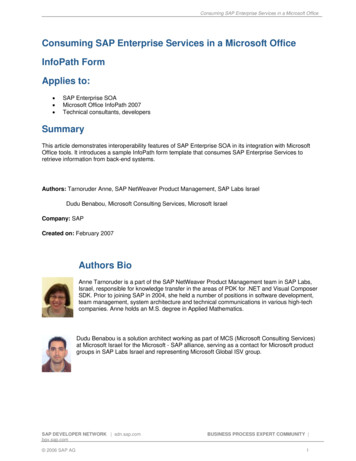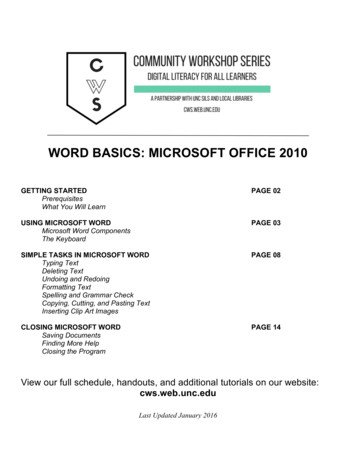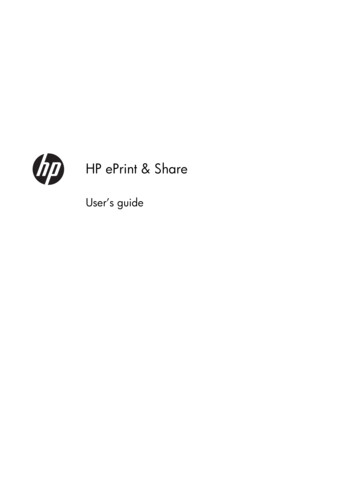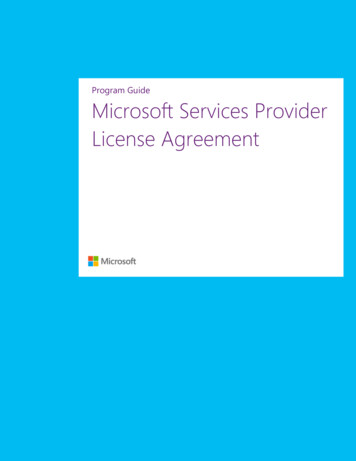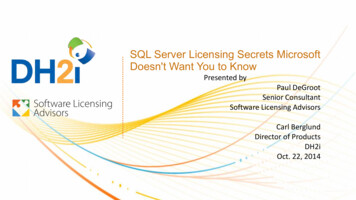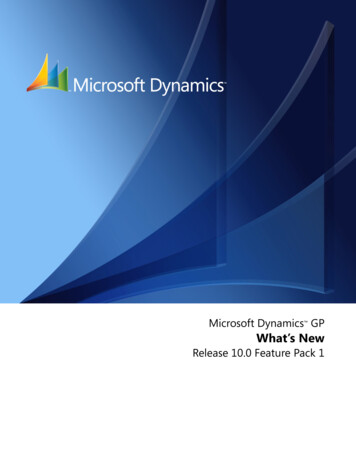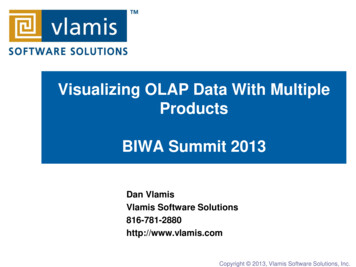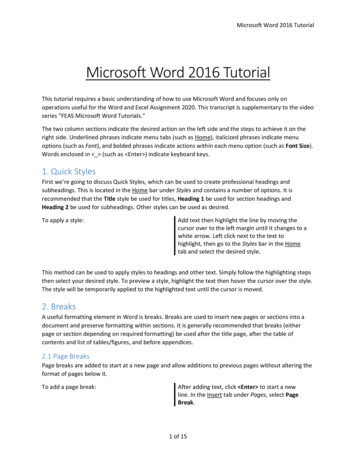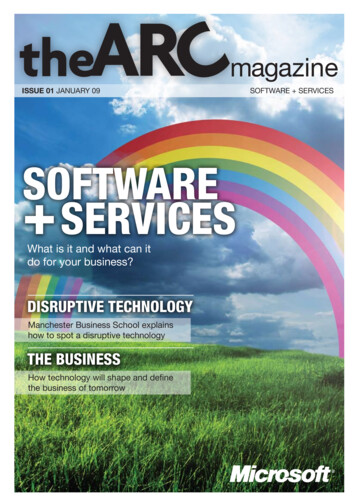
Transcription
magazineISSUE 01 JANUARY 09Software ServicesWhat is it and what can itdo for your business?disruptive technologyManchester Business School explainshow to spot a disruptive technologythe businessHow technology will shape and definethe business of tomorrowSOFTWARE SERVICES
Cover illustration: www.thesingingbird.com02ContentsWelcomeSoftware Services (S S) is the term that Microsoft hascoined to describe the next wave of computing that willdrive software developments over the next five years.The widespread availability of broadband, greaterbandwidth, cheaper networks and storage, plus a widevariety of internet-connected hardware devices mean thatit is now possible for people to stay productive whereverthey are and whatever device they have to hand.‘Always on’ internet connectivity has led to anexplosion of hosted applications that can be accessedfrom any device with a web browser. Some of these haveproved very successful, posing the question of whetherthe internet is now the optimum means of softwaredelivery (see the article by Dr Steven Moxey on page 6).The business case for running applications in the cloudis certainly compelling and Microsoft itself is active inthis area.However, it has flaws: even with overlapping WiFi,Wimax and 3G networks it is not always possible to getonline; the quality of a network connection cannot beguaranteed; and performance is frequently compromised.It also raises questions around security, access, thelocation of data and integration with systems alreadyresiding on-premise.Clearly, a one-size-fits-all model for software deliverywill no longer suffice. Instead, organisations shouldconsider a choice of delivery options encompassingeverything from hosted on-premise to hosted on-demand.Another element of the software equation that needs tobe considered is the client itself. Whether this is a mobile,a laptop or other connected device, there is a benefit inMatt Deacon03. The BackgroundHow Ray Ozzie set Microsoft on thepath to Software Services.exploiting the compute and offline capabilities that shouldnot be ignored.Take the messaging and collaboration server MicrosoftExchange as an example. This is widely installed on-premise,but it is also available as a hosted offering, either throughMicrosoft partners or Microsoft itself, giving customers thewidest set of delivery models to choose from.Next let’s look at Outlook, the client application ofExchange. The Outlook application installed on a user’slaptop has both on and offline capabilities for accessingand synchronising data. In addition, there is the OutlookWebAccess client, a browser-based client that allowsaccess when the user is away from his or her ownmachine; Outlook Mobile, which provides on and offlineaccess to emails from a mobile phone; and finally OutlookVoice, which gives voice-activated access to emails fromany type of phone. All provide different but synchronisedviews of the same data.Having this much flexibility and choice is the essenceof what Software Services is all about. In a nutshell,S S provides the best of both worlds: the power andusability of local software, plus the reach and flexibility ofthe cloud.In Issue One of The Arc, we aim to give architects,IT professionals and software developers a deeperunderstanding of the business case for Software Services. In subsequent issues, we will address thetechnical architecture of S S in greater depth.We hope you enjoy the read and gain an understandingof why Microsoft believes that a hybrid approach is thebest way forward for the IT industry and its customers.Chief Architectural Advisor, Developer & Platform Group, Microsoft UKQuestions or thoughts? Email; thearc@microsoft.com04. The Business BenefitsWhy Software Services makesgood sense for businesses anddevelopers.06. Disruptive or Radical?Is software as a Service a disruptivetechnology? Dr Steven Moxey looksat the evidence.08. From the Analyst’s ChairThe Arc speaks to Dale Vine ofFreeform Dynamics about how S Sfits into the IT landscape.10. S S in ActionWhy Solidsoft believes S S isevolutionary not revolutionary.Additional Contribution from:Koby Amedume: PlatformMarketing Lead, Microsoft UKMatt Deacon: Chief ArchitecturalAdvisor, Developer & PlatformGroup, Microsoft UKThe Arc magazine Software Services ispublished on behalf of Microsoft Ltd by NGTMedia Ltd. No part of this magazine maybe reprinted or used without the publisher’swritten consent. www.ngtmedia.co.ukMicrosoft Limited, Thames ValleyPark, Reading, RG6 1WG
03www.microsoft.com/architectSoftware Services:icrosoft regards Software Services (S S) as the fifthwave of computing aftermainframes, PCs, the internet and Web2.0. Others argue that the combination andintegration of enterprise and cloud-basedcomputing is not a new wave of computingat all but merely a maturation of the thirdor fourth wave.Wherever one stands on this debate,there is no doubt that in the next 5 to 10years S S will have a huge impact onsoftware development and delivery.The roots of Microsoft’s S S propositionlie in a Memo written by Microsoft chiefsoftware architect Ray Ozzie on October28, 2005 just months after he had joinedthe company.Entitled The Internet ServicesDisruption, the memo describes a“time of great turbulence and potentialchange in the industry” driven by thedramatic evolution of computing andcommunications technology to thepoint where a services-based model forsoftware delivery becomes viable.Ozzie wrote: “The ubiquity of broadbandand wireless networking has changed thenature of how people interact, and they’reincreasingly drawn toward the simplicity ofservices and service-enabled software that‘just works’”.In 2005, Ozzie identified three trendsthat were transforming the softwarelandscape: the use of advertising to fundthe creation and delivery of softwareand services; the use of the internetfor software delivery; and demand forproducts that delivered a seamlessexperience in which all the technology inan individual’s life just worked.He argued that Microsoft was in agood position to deliver this seamlessexperience and urged Microsoft divisionsto assess how services might impact andinfluence the design of Microsoft products.Microsoft teams had already developedsolutions along these lines, notably inthe areas of messaging and gaming, butOzzie’s memo made it a priority for thewhole company, as he felt that ‘the servicedisruption’ would spread to enterpriseswhere services would be combined withan organisation’s existing software.Software ServicesFast forward to October 27-30 2008 andthe Microsoft Professional DevelopersConference (PDC) in Los Angeles whereMicrosoft unveiled some of what it hasbeen working on in response to the call toarms issued by Ozzie in 2005.Microsoft already has a range of hostedservices, including Exchange Online,SharePoint Online, Microsoft DynamicsCRM Online, Office CommunicationsOnline and Office Live Meeting, which canbe used as a complement or addition toon-premises software.However, unlike advocates of Softwareas a Service (SaaS), Microsoft does notbelieve that everything will reside in thecloud and be accessed by a browser. Itenvisages a much more inclusive future,in which SaaS is just one point along aspectrum of delivery models and S Srepresents a converged, or blended,approach to software delivery thatincludes desktop and server software andWeb-based services.At PDC, Microsoft ushered in a newera of S S with a preview of WindowsAzure, a services platform that will enablesoftware developers to deploy applicationsusing cloud-based Internet services,on-premises servers or a combination ofthe two, with full synchronisation betweenonline and offline working.For ease of integration, they will beable to do this using skills, tools andtechnologies already broadly familiarto them, such as the Microsoft .NETFramework and Visual Studio, plus awide range of commercial or open sourcedevelopment tools and technologies.ThebackgroundWindows Azure, which combines cloudbased developer capabilities with storage,computing and networking infrastructureservices, is a key component of Microsoft’sAzure Services Platform.This platform already offers MicrosoftSQL Services for database services andreporting; Microsoft .NET Services forservice-based implementations of.NETFramework concepts such as workflowand access control; Live Services, whichgive users a consistent way to store, shareand synchronise documents across PCs,phones, PC applications and Web sites;and Microsoft SharePoint Services andMicrosoft Dynamics CRM Services forbusiness content, collaboration and rapidsolution development in the cloud.Microsoft’s S Sstrategy startedin 2005 with aMemo written byMicrosoft chiefsoftware architectRay OzzieOffice onlineAs a developer of software products inits own right, Microsoft has been usingthese tools in its own applications notablyWindows Live, Office Live, Xbox LIVE andLive Mesh. At PDC, it also demonstrated‘Web applications for the Office’. Theselightweight versions of Microsoft OfficeWord, Excel, PowerPoint and OneNote canbe operated from within Web browsersand are fully compatible with existingphone and PC versions of Office, so thatusers can view, edit and collaborate on thesame rich document regardless of the typeof Office used. Web applications for theOffice will be included in the next versionof Microsoft Office and will be availableto individuals through Office Live, and tobusinesses though a hosted subscriptionservice and existing licensing programs.In both its roles, as platform providerand software developer, Microsoftis showing how S S can be used totransform software delivery. Developersbenefit from simpler, faster and lower costproduct development and customisation,while their customers can look forward toseamless working on and off-line.JARGON ?Software PlusServices (S S)The idea of combininghosted serviceswith locally runningsoftware to provide aricher, better solutionfor users.Cloud computingThe use of computertechnology withresources providedas a service overthe Internet relievingusers of the need forknowledge, expertiseor control of theproducts.
04An ON andSoftware ServicesBy combiningthe speed andfunctionality ofclient softwarewith the flexibilityof online services,Software Servicesovercomes thelimitations of SaaS.Questions or thoughts? Email; thearc@microsoft.comhe pace of technological changeis relentless. In a very short space oftime we’ve gone from big standalonemainframe systems that once ranentire businesses in isolation to networkedPCs with a global reach and a vast array ofmobile computing devices with ten timesthe processing power of their gargantuanpredecessors.The Web itself has brought increasedcompetition and a new set of challenges, butalso new possibilities and new ways of doingbusiness and interacting with colleagues andsuppliers. The challenge for IT managers ismaking the most of these opportunities at atime when budgets are being slashed.So how can businesses do more withless, without compromising reliability andrisking system downtime?Faced with the need to economise,business managers might regard now as agood time to outsource. Yet many see pureoutsourcing and Software as a Service(SaaS) as risky, and enterprises are oftenreluctant to place all their faith in hostedapplications. Even now, chief informationofficers (CIO) and IT managers can bewary of entrusting their crown jewels toan outsider, preferring to keep them safewithin the perimeter fence – a mindsetthat can be tough to break.Software Services (S S), whichcombines the benefits of running clientsoftware on a device, e.g. speed andfunctionality, with the flexibility of Internetservices, is an attractive propositionbecause it gives enterprises theopportunity to reduce both cost and risk.By using a mixture of software and hostedservices, companies can reduce theircapital expenditure (CapEx) significantlyand reap the benefits of paying forsoftware on subscription out of operationalexpenditure (OpEx).This scenario has many otheradvantages, notably an offline capabilitythat differentiates it from SaaS; and asimpler means for companies to upgradeand future-proof systems.“I think many want to keep fully onpremise but then there is an opportunitycost equation that comes into play,”explains Matt Deacon, chief architecturaladvisor, Development and Platform Group,Microsoft. “Forward-thinking companiescan see the benefit of a mix and areexploring a hybrid architecture or blend ofon-premise and on-demand. They havea handle on their architecture and viewintegration as part of their strategy.”Deacon points out that because mostorganisations have existing investmentsthey can ill afford to rip out and becausevery few operate in isolation, the sensiblestrategy is to find ways for existingsystems to collaborate or share data withother services.“Forward thinking companies regardintegration as a strategic advantage andposition it so,” he says. “They don’t justview their architecture as a ‘build versus
05www.microsoft.com/architectOFF affairbuy’ equation, but as an ‘integration, build,buy’ equation. The point of service orientedarchitecture (SOA) was to answer thequestion of how to leverage existing assetsrather than replace them.”S S takes this model further forward,placing equal importance on a newtechnology’s ability both to fit in with anorganisation’s overall integration strategyand to solve a particular business problem.In reality, this is the directionorganisations have been travelling for yearsand vendors have been swift to realise thatif they are to provide a satisfactory end userexperience, total reliance on a web browserisn’t always enough: companies requiredesktop components to link with legacysoftware, too.As Bob Tarzey, business process analystat Quocirca, puts it: “Software Servicesdescribes the reality of how software isactually delivered these days Indeed,research shows that most independentsoftware vendors (ISVs) are evaluatingon-demand delivery at some level andmost businesses are using this at somelevel too.”Dynamic updatesOne of the key benefits for vendors andIT managers is the ability to provide dataand updates dynamically as appropriate,something that is likely to be of particularinterest to smaller organisations withlimited IT skills.“Software Services is Microsoft’sapproach to some trends in themarketplace – the increased penetration ofInternet access and the increased numberof connected devices we use,” explainsSteve Clayton, services lead, MicrosoftInternational. “This combination enablesnew ways to deliver experiences that spandevices and take advantage of increasedaccess to the Internet.”Many businesses will use on-demandofferings for obvious things like hosted emailor web conferencing tools that are on-demandby their very nature. However, more and moreare now using this model for critical businessapplications because networks are sufficientlyreliable and because on-demand applicationsare a great way to support fast moving trendsin business.Uptake is being driven by the moveto mobile and flexible working, ason-demand gives employees access toapplications wherever they happen to be.The model also lends itself well to crossorganisational business processes, wheremultiple organisations share applicationseasily and securely – handy for supportingthings like complex supply chains in aglobalised economy.In all of these scenarios it’s importantto retain control over process and guardagainst latency, which can occur with pureSaaS. This is where the mixture of onpremise and on-demand has real benefits.Architecturally, this demands thoughtabout how you build an application, whereyou put the user interface, business logicand data, as there are multiple placesthese can go. More than this, it requiresintegration to have strategic importancewithin the organisation as a whole.“This is why SOA has enjoyed so muchpopularity for so long,” says Deacon. “Theproblem has been in delivering on thispromise. The businesses that are succeedingare those that have adopted SOA at anorganisational or business level, not just as atechnical or solution architecture.”Clayton adds: “The SaaS approachputs all of this in the cloud, whichprovides great flexibility on updates etc.but compromises on performance andavailability – especially if you have noInternet access. On the other hand, puttingall of this on the device makes updatingharder too.”JARGON ?The big challengeS S offers the benefit of integration but, formany, this is also the biggest challenge or fear.“It can be all too easy to think of asolution as residing in one domain oranother such as on- or off-premise,” addsDeacon. “The fear rises once you start tothink of this solution as a mix.”SaaS solutions make sense becausetypically they represent a complete ‘finished’service like CRM, for example. All associateddata exists within the domain of that solutionso it is easy to envisage it all residing on- oroff-premise. Integration problems start tooccur when you share things like customerdata with the purchase order system thatyou already have on-premise.“The key tenet of S S is integration - aconcept it inherits directly from SOA,” explainsDeacon. “Any solution that bases itself on thisconcept is already focused on addressingthe needs of integration and is more ableto engage as a business process that takesadvantage of existing assets whether theythemselves are on- or off-premise.”Once users have this in mind, the ideaof going to a ‘cloud’ of networkedcomputing resources offsitebecomes more and more attractive.Above all, it makes it possibleto harness the cost benefitsof SaaS and the reliability ofa familiar architecture thatremains onsite to enableon- and off-line workingas required.SaaSWhere an applicationis hosted as aservice provided tocustomers via theInternet.Service OrientatedArchitecture (SOA)Where methods forsystems developmentand integrationgroup aroundbusiness processesand are packagedas interoperableservices. SOA alsodescribes an ITinfrastructure thatallows differentapplications toexchange data withone another asthey participate inbusiness processes.
06ServicesSaaS Is SaaS a radicalor a disruptivetechnology?Dr Steven Moxeyconsiders theevidence.AuthorDr Steven Moxeyis Research Fellowat ManchesterBusiness School.www.mbs.ac.ukdisruptionhe idea of disruptive technologyis well established and occurrencescan be identified throughout history,where new tools and practices thatstarted at the fringe of society emerged torival and supersede existing technology.The term ‘Disruptive Technology’ was firstintroduced by Clayton Christensen andJoseph Bower in their leading 1995 articleDisruptive Technologies: Catching theWave,1 in which they describe the scenariowhich affected the creators of disk drivesfrom the 1970s to the 1990s. No individualdisk drive manufacturer was able todominate the market for more than a fewyears, each manufacturer repeating themistakes of others by failing to understandthe nature of disruptive technology.Since the mid ‘90s the Internet hasplayed a significant role in shaping thesoftware industry. In 2004 at a conferencebrainstorming session between O’Reillyand MediaLive international, the popularterm of Web 2.0 was born and with it awave of interest focusing on the idea ofthe web as a platform for software delivery– now known as Software as a Service(SaaS). In 2005, Ray Ozzie, Chief SoftwareArchitect at Microsoft, articulated theimportance of this new model for softwaredelivery in his memo entitled The InternetServices Disruption.2 Could SaaS be thenext disruptive technology?Radical or disruptive?Technology-based innovations areoften classified as radical innovations,frequently originating in R&D labsand offering significant functionalperformance over the old technology, oras incremental innovations, which tendto be customer driven and deliver moreQuestions or thoughts? Email; thearc@microsoft.commodest improvements. In both cases thetechnology innovation delivers against theneeds of current customers of the firm.A good example of a radical innovationis the development of the jet engine,which certainly offered breakthroughperformance against well-establishedcustomer needs for military and civilaviation. A company with a radicalinnovation is likely to enjoy a significantcompetitive advantage.By contrast, disruptive technologyinnovations are more complex and can bestbe understood as a series of steps leadingto disruption. During a Manchester BusinessSchool/Microsoft SaaS research project asimple disruptive technology frameworkwas used to explain the idea of disruptivetechnology (Figure 1) .Disruptive Technology FrameworkThe first step in the disruptive technologyjourney is an existing product, which issuccessfully sold to meet existing market(customer) needs.A new technology innovation, potentiallydisruptive, then occurs which creates anew set of products. Interestingly, firmsalready in the industry often develop thenew innovation.The firm then tests the innovation withexisting customers, a very natural step.However, for a disruptive technology thecustomer feedback is not good sincedisruptive technologies fail to meet keyneeds of existing customers and hence itdoes not appeal (a radical technology bycontrast will appeal to existing customers).The firm then seeks out new marketsand applications for the new disruptivetechnology. In many cases new marketsare created, or enabled, by a disruptivetechnology. The new markets may growto be many times the size of the originalmarkets served by the firm. This growthhelps the firm to refine and improve theperformance of the disruptive technology.Finally, the performance of thedisruptive technology has improved to theextent that it can successfully re-invadethe original market and disruption occurs.Figure 1. The disruptive technology frameworkKey ValuesKey ValuesWhat are the keyattributes of atraditional product?What are the key needsfrom any existingcustomer perspective?Key ValuesKey ValuesWhat are the keyattributes of thenew product?What are the key needsfrom a new marketcustomer perspective?
07Demandedby UsersOffered byDisruptiveTechnologyTimeUnfortunately information on new marketsis notoriously hard to come by, especiallyquantitative market sizing, and this makesit challenging for firms to develop businesscases for disruptive technology, comparedto radical or incremental innovations.(see Bower and Christensen, 1995)Figure 2. demanded performanceThe actual point of disruption can beidentified as the point where the disruptivetechnology performance exceeds thecustomer’s demanded performance line,see Figure 2. This means that existingcustomers will accept the disruptivetechnology. Note that the originaltechnologies often carry on improving aswell but customers are not prepared to paya premium for additional performance.Demanded PerformanceA technology is disruptive when it hascompleted all of the five steps, which mayof course take some time. It is easy toidentify a disruptive technology innovationwhen it has run its course, by which time itis usually too late!An interesting example of a potentialdisruptive technology in progress may bethe Wii games console. Traditional gamingcustomers value realism and complexgameplay – the market is served bySony (Playstation), Microsoft (Xbox) andNintendo (step 1); Nintendo develops newtechnology innovation, the wand (motionsensor) (step 2); this is unlikely to appealto hard core gaming customers (step3); so Nintendo creates the Wii productand targets a new market for leisureand families (step 4). This has proved tobe very successful and Nintendo is stillstruggling to meet demand. Will there bean opportunity for disruption of the coregaming markets by the Wii? It is difficult tosay but that may be less important if thenew leisure gaming segment proves largeand profitable.Understanding the needs of newand existing market segments is veryimportant to the successful managementof disruptive technology innovations.Software as a ServiceSoftware as a Service (SaaS) is an importantnew development for the software industry,which may have disruptive potential. In 2008Manchester Business School and Microsoftcompleted an investigation amongst ISVsand Enterprise customers to assess thepotential of SaaS as a disruptive technology.Seventy-five UK ISVs were surveyed,supported by three customer focus groups,to assess SaaS’s potential for disruption andto classify their own innovations (based onSaaS) as disruptive or radical/incremental.Disruptive technology enjoys a highdegree of awareness and understandingamongst ISVs, with 70% of the sampleagreeing that they understood disruptivetechnology and 67% believing thatdisruptive technology is important to theirbusiness. The vast majority of UK ISVs,81%, are aware of SaaS and 71% believethat SaaS has disruptive potential. Indeed56% are already creating innovationsbased on SaaS. This shows the importanceof disruptive technology innovation toMicrosoft UK ISVs.To distinguish between disruptive andradical innovations, proven measurementscales3 were employed to create adisruptive innovation index and a radicalinnovation index, both ranging from 0 to apossible maximum score of 100.The disruptive innovation index for SaaSwas measured as 54.5, and the radicalinnovation index as 60.4 (see Figure 3).Radical and DisruptiveInnovation IndexThese results suggest that the innovationsunder development by UK ISVs may bemore radical (aimed at existing markets)than disruptive (initially aimed at newmarkets). For more details, view the fullreport online at http://tinyurl.com/8bdw26.HighDisruption!DVD: VHSCordless PhonesJet Engine:Piston EnginesCalculator:Slide RuleMobile: LandlineiPod: WalkmanDisk DrivesDell DirectSchwabLowOffered byEstablishedTechnologyRadicalPerformance Metric e.g. cost per gure 3. radical and disruption innovation indexThe most important driver for disruptivetechnology innovation was found tobe senior management belief in theinnovation. The more senior managementunderstands and supports disruptivetechnology innovations, the more likely itis that investments will be made. The mainbarrier to exploiting disruptive technologyinnovations appears to be allocatingresources to disruptive technologyinnovation ahead of established productsand business. This is the same conclusionreached by Joseph Bower and ClaytonChristensen in their work on disruptivetechnology.1 The solution to this problemmay be better management awareness ofdisruptive technology innovation and ringfenced investment for new innovations.The goal for companies with disruptivetechnology is to create surprise for thecompetition. ISVs should seek to avoiddisruptive technology surprises in theirmarkets by scanning for new technologiesthat have applications relevant to theirbusiness. Once a technology is identified, acompetitive strategy to counter the disruptioncan be prepared including partnershipopportunities with the new entrant.In summary, SaaS technology certainlyshows the potential for disruptiveinnovation but we will have to wait sometime yet before a definite judgment canbe made and the business school casestudies written.FOOTNOTES[1] Bower, J. L. &Christensen, C. M.(1995) DisruptiveTechnologies:Catching the Wave.Harvard BusinessReview, 73, 43-53.[2] The InternetServices Disruption,Ray Ozzie.http://tinyurl.com/8523v7[3] Easingwood,C. & Moxey, S.(2006) ‘BringingHigh Technology toMarket: SuccessfulStrategies Employedin the WorldwideSoftware Industry’Journal of ProductInnovationManagement, 23,498-511.
08Dynamic ITevolves with S SThe futureThe Arc spoke toDale Vile, researchdirector at FreeformDynamics, aboutwhere Software Services fits intothe evolving ITlandscapeJARGON ?.NetA Microsoft softwareframework availablewith severalMicrosoft Windowsoperating systems.It includes manypre-coded solutionsto commonprogrammingproblems plus avirtual machinethat managesthe execution ofprograms writtenspecifically for theframework.wo major problems that haveexisted for decades in relation toIT systems are inflexibility andfragmentation, and the software layerhas played a big part in this.Indeed, until recently acquiring softwarewas a case of making choices andhaving to live with them for long periodsuntil upgrades or replacement bespokeapplications were developed. Thesechanges themselves caused upheavaland posed significant risks and costs tobusinesses, as they involved the need forintegration or re-integration.The good news is that thinking,technology and standards have nowevolved to a point where organisations canlook forward to a much smoother evolutionof their IT landscape.Dynamic ITToday, IT is moving towards a more dynamicmodel. Virtualisation has been accepted atthe hardware or systems layer, and whilethere is still a long way to go, developmentsand experience in this space have shownenterprises the potential of a more dynamicapproach to business operations, too.In the solution space a similar spirit hasemerged, notably with Service OrientedArchitecture (SOA), which supports theidea of flexibility, ease of integration andthe smooth evolution of systems. Whilethere has been some confusion over howbest to bring SOA on board for internaldevelopments, packaged applicationvendors have invested heavily in thisarea and are introducing SOA into the ITlandscape through the ‘side door’.Dale Vile, research director at FreeformDynamics, believes that this forms afoundation on which many will build, notnecessarily consciously thinking of SOA, butQuestions or thoughts? Email; thearc@microsoft.comat least embracing the concept of servicesand standards-enabled integration.“Once you start down that road, you arenot only able to move things around andsubstitute components within your owninfrastructure, you are able to move thingsacross company boundaries,” he says.“This opens the door to a few things.Firstly, getting third party service providersto host some of your infrastructure foryou, whi
Microsoft unveiled some of what it has been working on in response to the call to arms issued by Ozzie in 2005. Microsoft already has a range of hosted services, including Exchange Online, SharePoint Online, Microsoft Dynamics CRM Online, Office Communications Online and Office Live Meeting


